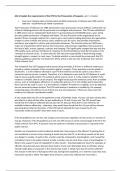AC2.1 Explain the requirements of the CPS for the Prosecution of Suspects. ac2.1 (4 marks)
• must cover charging roles (criminal justice act 2003), prosecution of offences acts 1985, and full
code test - requirements cps needs to prosecute
The Prosecution of offences act 1985 derived the crown prosecution service (CPS) to combat the risk
of bias in allowing police to be the personnel to investigate and prosecute. The CPS was established
in 1986 and is now an independent body that it is prosecuting around 500,000 cases a year, being
the main public prosecutor of England and Wales. The key functions of this organisation are to
decide if there is enough evidence for a case to go to court where helping determine the appropriate
charges in more complex and serious cases, prepares case for court, and provides information,
assistance, and support to victims and prosecution witnesses. The criminal justice act 2003 was a
major act of parliament which laid out key instructions and processes regarding criminal justice in
the face of bails, arrests, appeals, cautions and charging. This significantly changed the way that the
CPS handles cases and was introduced in response to recommendations made by lord justice in his
‘reviewal of criminal courts.’ it meant that the CPS now had responsibility in determining charge
brought against a suspect in most cases. To decide whether a case should be prosecuted, the CPS
follows guidelines called the ‘Full Code Test’ (FCT), which is split into the ‘Evidential Test’ and the
‘Public Interest Test’.
The ‘Evidential Test’ (ET) happens before prosecuting and looks at if there is sufficient evidence to
provide a realistic prospect of the conviction against a suspect. Three questions must be asked to
decide this: 1. Is the evidence allowed in court? If the evidence cannot be used in court, then it
cannot be used to convict a suspect. Therefore, if it is allowed in court and the CPS believes it could
help to secure a guilty verdict, the evidence will be used in court. 2. Is the evidence reliable? If the
evidence is reliable, then it can be trusted. This might be because the evidence comes from a reliable
source, such as investigative officials or a trustworthy witness. If it is not reliable and trustworthy,
then it cannot be used in court. 3. Is the evidence credible? If evidence is credible, it can be believed,
but not necessarily always trusted. The CPS could analyse if evidence is credible by, for example,
comparing pieces of evidence to see if there are any inconsistencies. If there are none, then the
evidence can likely be considered credible.
A case study which the ET can be applied to is that of Damilola Taylor. He was a 10-year-old boy who
was killed in a block of flats after he was stabbed by a 12 and 13-year-old. The CPS should have
found that the evidence collected did not pass the ET, because they didn’t cross-reference all
available evidence effectively - otherwise, they would have found that the 14-year-old key witness
was lying about what she had seen. If the CPS had not allowed the case to pass the ET, the
inaccurate evidence wouldn’t have been used in court.
If the ET guidelines are not met, the charge cannot proceed, regardless of how serious or sensitive it
may be. However, if the ET guidelines are met, the CPS moves on to the second stage of the FCT: the
‘Public Interest Test’ (PIT). A decision must be made as to whether a prosecution is required in the
public interest.
Another set of questions must be asked to decide this: How serious is the offence? A parking fine is
not considered a serious crime, meaning it would not pass the PIT, as the driver would not be seen
as a danger to society. As well as this, murder could be compared to manslaughter, and it would be
considered more in the public interest to take a murder case to court than a case of manslaughter. 2.
What is the suspect’s level of culpability? In other words – how blameable are they? For example, an
offender who planned every decision they made is much more blameable than an offender whose
mental health plays a heavy part in the actions they make. 3. What harm has the victim suffered?
This may be in the form of having lost their job, having been exploited, or in extreme cases they may
have been injured or killed. The higher level of harm a victim has suffered, the more that a




